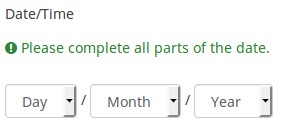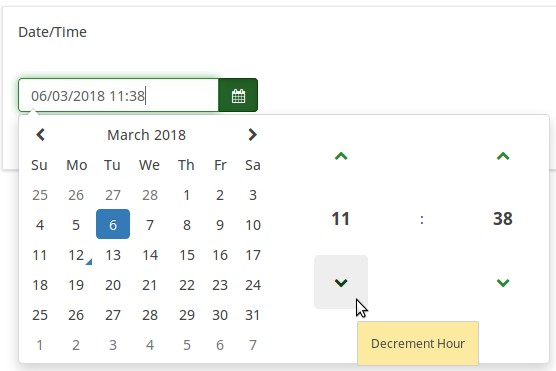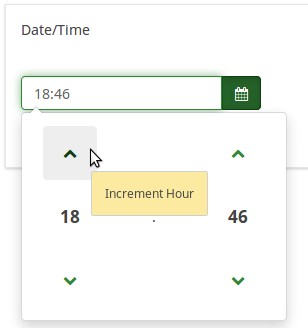Type de question - Date
From LimeSurvey Manual
Brève description
Ce type de question peut être utilisé pour demander une date, une heure ou une combinaison des deux. Dates et heures peuvent être entrées directement, choisies depuis un calendrier popu^ou depuis une liste de choix. En ce qui concerne la validation, des dates minimum et maximum peuvent être précisées. Divers formats de date et d'heure sont supportés, certaines de ces fonctionnalitésne sont disponibles que depuis la version 2.05+.
Core settings
Mandatory
Description
This option allows the survey administrators to request their respondents to answer certain survey questions. If the mandatory questions are not answered, the respondents will not be able to proceed further. If you have a question with multiple subquestions, and you require only certain subquestions to be answered, use the minimum answer attribute located under the Logic tab.
Available options
- On - Question must be answered before the participant can proceed to the next page - the answer option 'No answer' is never shown.
- Soft - If the question is not answered, a warning is shown when trying to proceed to the next page - however, the participant can choose to ignore the warning and proceed. Note that the 'No answer' option is still shown (if activated in survey presentation settings)
- Off (default) - Question can be left unanswered
Condition (previously "Relevance equation")
Description
If the result value of the condition is "1" or "true", the question is "relevant" in the survey context, i.e. it is shown to the survey participant. If not, the question is hidden. Any survey question allows you to specify a relevance equation. This function is the successor of conditions and supports much more complex conditional logic.
Syntax Highlighting
Whenever you save the condition, it is evaluated and syntax-highlighted. Any errors will be color coded so that you can quickly detect and fix them.

Valid values
- Any condition that makes use of the ExpressionScript syntax, without surrounding curly braces.
Examples
Here are good examples of syntax highlighting.
Advanced settings
Reverse answer order (reverse)
Description
If activated, the order of the answers will be reversed.
Available options
- On
- Off (default)
Example
Let's assume that you want to use an Array (Numbers) question type. If this option is disabled (default value), then the possible answers a survey participant can select are: "1, 2, 3, ... , 10". If enabled, the setting will reverse the order of the available answers: "10, 9, 8, ... , 1".
Randomization group name (random_group)
Description
It places the questions into a specified randomization group, all questions included in the specified group being displayed in a random order to the survey respondents.
You can find a sample survey using randomization group name in ExpressionScript sample survey.
Valid values
Just enter any string you like (for example: 'group1'). All question which have set the same string within the randomization group name box will have their place in the survey randomized (=randomly exchanged among each other).
Preview
To preview the questions use the preview survey instead of the preview question group function, as the second has been reported to not show the questions in a randomized order.
Display dropdown boxes (dropdown_dates)
Description
If enabled, the date/time question type will display a dropdown box to the respondents from where to choose the date/time, instead of the default popup.
Available options
- On
- Off (default)
Example
If it is turned on, the question will be displayed in the following way:

Description
If enabled, the question will always be hidden - it will not be displayed to the survey participants. This function can be used in the following scenarios:
- If you wish to prefill a question with a URL and you want not to have it displayed on the screen. This overrides any conditions used within the survey because the respective question will not even be embedded on the page.
- If you wish to store or calculate a value on the fly via the ExpressionScript - Presentation.
Available options
- On
- Off (default)
Minimum year (dropdown_dates_year_min)
Description
This question attribute can be used to set the minimum year value for the calendar question. It applies to the dropdown- and to the popup-variant of the calendar.
Valid values
Any year value
Maximum year (dropdown_dates_year_max)
Description
This question attribute can be used to set the maximum year value for the calendar question. It applies to the dropdown- and to the popup-variant of the calendar.
Valid values
Any year value
Minimum date (date_min)
Description
This question attribute can be used to set the minimum value for a date question (in y-m-d format or any English valid string - see below for more details). It can be used for both popup and dropdown display options. If a minimum date is not set, then 1.1.1900 is used as default.
Valid values
- Any date value in format YYYY-MM-DD (eg., 2017-08-24);
- Any year value;
- Any English string : "now", "-10 years", "tomorrow";
- Reference to another date/time question : AnotherDateQuestion (using the question code);
- Expressions : With expressions, a minimum date can be dynamically calculated. For example, you can use a date from a previous answer + 3 days as a minimum for the present question by entering: date("Y-m-d",strtotime(departuredate)+3*60*60*24).
Maximum date (date_max)
Description
This question attribute can be used to set the maximum value for the date question (in y-m-d format or any other English valid string - see below for more options). It can be used for both popup and dropdown display options.
Valid values
- Any date value in format YYYY-MM-DD (eg., 2018-08-24);
- Any year value;
- Any English string : "now", "-10 years", "tomorrow";
- Reference to another date/time question : AnotherDateQuestion (using the question code);
- Expressions: With expressions, a date can be dynamically calculated. For example, you can use a date from a previous answer + 3 days as a maximum date for the present question by entering: date("Y-m-d",strtotime(departuredate)+3*60*60*24).
Date/Time format
Description
This question option can be used to specify a custom date format. If it is empty, the survey date format will be used.
Valid values
- The d/dd,m/mm,yy/yyyy,H/HH,M/MM formats can be used to display the date and/or time, while "-", ".", "/", ":" can be used as separators.
Examples
- yyyy-mm-dd - year-month-day;
- dd.mm.yyyy HH:MM - day.month.year Hour:Minute;
- HH:MM - Hour:Minute (only the time can be selected);
- yyyy/mm - year/month.
Tip for whole question validation equation (em_validation_q_tip)
Description
If you are using the question validation equation, you can use this box in order to display an optional message as question tip on how the question has to be filled out.
Valid values
- Any string or equation that makes use of the ExpressionScript syntax.
Example
See the example from the question validation equation wiki section- it shows how the tip can be tailored to show which parts of a multiple short text question fail the validation criteria.
Insert page break in printable view (page_break)
Description
This attribute is only active when you actually print a survey from the Printable View. It forces a page break before the question.
Available options
- On
- Off (default)
Dates et Expression Manager : Calcul et validation avancés
Limesurvey version 2.05+ et au-delà rend tout à fait facile de valides des dates en utilisant les champs date_max et date_min (voir ci-dessus). Utilisez les aussi souvent que possible. Si vous avez besoin de faire des choses plus "fantaisistes", vous pourrez travailler (et calculer) avec les dates en utilisant l'Expression Manager et la fonction strtotime() (New in 2.0 build 130515); Elle calcule le nombre de secondes entre le 1 Janvier 1970 et une date donnée. exemple : si vous voulez afficher dans une question de type texte le nombre de jours ecoulés entre une date de départ (demandée dans une question précédente) et aujourd'hui, vous pouvez utiliser l'expression {(strtotime("now")-strtotime(departure))/60/60/24}. Attention : strtotime() fonctionne avec beaucoup de formats de date mais pas TOUS. Le format de date par défaut de Limesurvey (MM-JJ-AA) ne fonctionne PAS avec strtotime(). Configurez vos questionnaires pour qu'ils utilisent un des formats de dte suivants pour éviter les problèmes : AAAA-MM-JJ, AAAA/MM/JJ, JJ.MM.AAAA, MM/JJ/AAAA, JJ-MM-AAAA.

